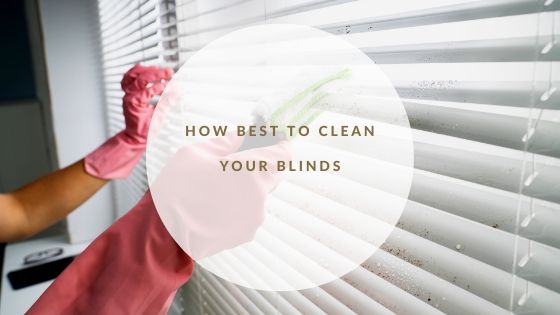Please wait...
How Best to Clean Your Blinds
This entry was posted 11/03/2020

Whatever you have in your home – curtains or blinds, be they wooden or material, roller or Roman, regular cleaning is important to prevent the build-up of dust and to keep them looking (and smelling) great!
Cleaning Equipment
The cleaning equipment you use will likely depend on the style and material of your blinds, and whether you’re giving them a quick dust or cleaning to remove stains or built-up dust. We would suggest the following:
- Slat cleaner – a specially shaped duster with washable covers, this is designed for dusting venetian wooden or aluminium blinds or shutters, allowing you to wipe each slat individually quickly and easily.
- Feather duster – suitable for removing dust from wooden and aluminium blinds and the tops of curtain poles.
- Clean cloth – use a dry cloth for wooden or aluminium blinds, and a clean damp cloth for material blinds like roller / Roman blinds and vertical blinds.
- Soft brush hoover attachment – this can be used to clean wooden or aluminium blinds as long as the attachment is soft enough not to leave scratches. It also works well for cleaning Roman blinds, brushing from top to bottom, and curtains.
Some curtains can be washed on a low, delicates-washing machine cycle – this will depend on the materials, so check the cleaning instructions carefully first.
Cleaning Methods
The way you clean your blinds will vary depending on the style and material.
Venetian blinds are best cleaned with a slat cleaner or feather duster. For built-up dust or stubborn stains, use a clean, damp cloth – just bear in mind that water can damage wooden blinds, so don’t use too much moisture. Baby wipes also work well for wooden blinds, and washing up liquid can be used for aluminium blinds.
Top tip: If using a damp cloth, make sure you go over any damp patches with a dry cloth to avoid smearing.
Roman blinds can be dusted or hoovered with a brush attachment for regular dust removal. Stain removal will depend on the material so check the cleaning instructions for yours. You may be able to use baby wipes on stains, and an odour removal spray can be used to keep them smelling fresh.
Top tip: Avoid using stain remover on your fabric blinds – it’s likely to cause discolouration.
Vertical blinds are often wipeable, so you can use a damp cloth or a feather duster for regular dust removal.
Top tip: Don’t forget to clean the headrail and connecting chains as well as the blinds themselves. You can use a duster, damp cloth and baby wipes.
Curtains can often be either machine or hand washed, but check the cleaning instructions first; this will depend on how delicate the material is. For regular cleaning you can use a hoover brush attachment.
Top tip: When cleaning your curtains don’t forget to give the poles and tracks a clean too – you can use a feather duster, damp cloth or baby wipes.
How Often Should I Clean my Blinds and Curtains?
Generally speaking, to avoid the build-up of dust on your blinds it’s a good idea to give them a light dust with a dry cloth or feather duster each time you dust your room. The frequency of this will no doubt depend on how busy your home is and how likely it is to build up dust, so this could be weekly, fortnightly or monthly, depending on how often you think it’s necessary.
More thorough cleaning is only really necessary either to remove stains or heavy dust build-up, or perhaps as part of your annual spring clean.
If you’d like some advice on your curtains and blinds, feel free to get in touch and we’d be happy to help.
This entry was posted in Uncategorized on 11/03/2020

